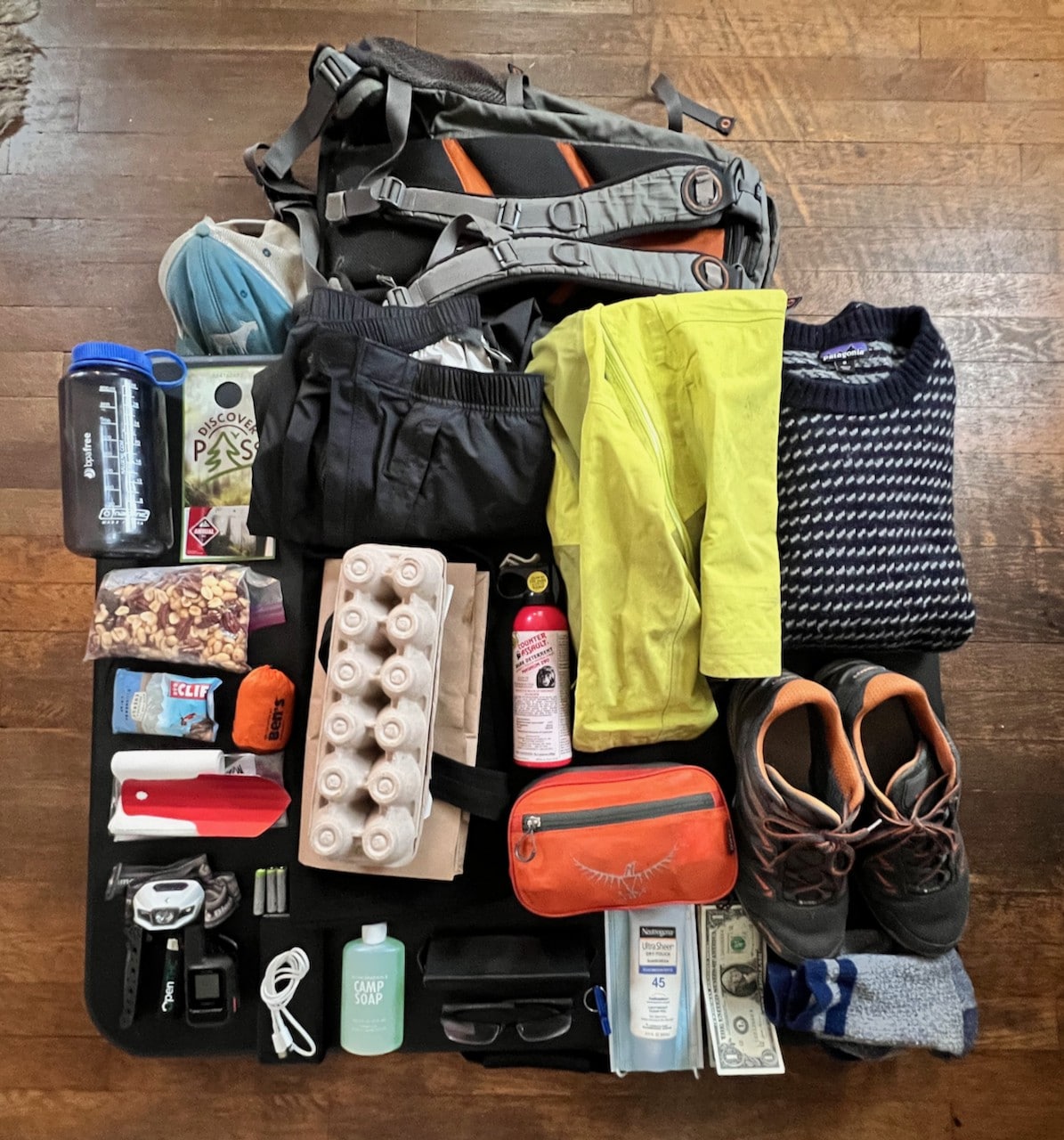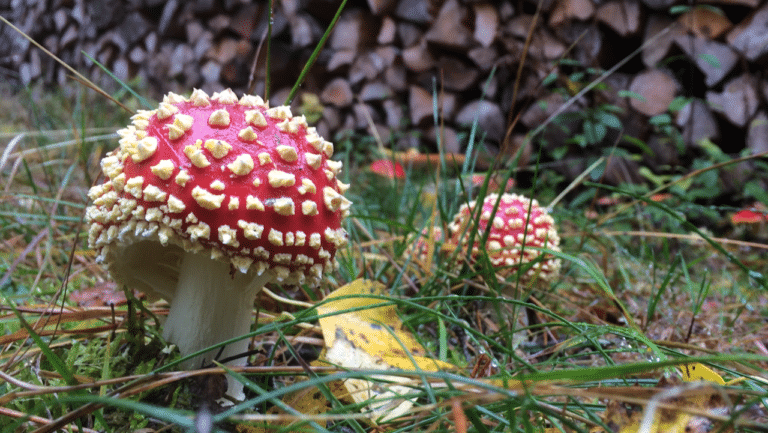What to bring mushroom foraging
[et_pb_section fb_built=”1″ admin_label=”section” _builder_version=”4.16″ global_colors_info=”{}”][et_pb_row admin_label=”row” _builder_version=”4.16″ background_size=”initial” background_position=”top_left” background_repeat=”repeat” global_colors_info=”{}”][et_pb_column type=”4_4″ _builder_version=”4.16″ custom_padding=”|||” global_colors_info=”{}” custom_padding__hover=”|||”][et_pb_text _builder_version=”4.23.4″ _module_preset=”default” hover_enabled=”0″ global_colors_info=”{}” sticky_enabled=”0″]
Packing for a foraging trip involves preparing for your safety, comfort, and pleasure. Much of this list is built around personal preference, length of trip, and local weather conditions.
The basics
What to wear
Mushroom foraging is often in cool, damp forests. Dress for the weather, and be prepared for changing conditions.
I typically wear:
- Synthetic hiking pants
- Smartwool shirt
- wool socks
- sneakers
I might also pack:
- sweater for cooler days
- rain jacket/pants for rain, damp understory, or extra warmth
Phone
Bring a fully charged phone. You may not have mobile service but maps downloaded to your device can be especially helpful. You can check coverage maps for your carrier for the area where you plan to forage.
Food and Water
I often carry a bottle of water and a few snacks.
Permits
The most common permits you might need are a parking permit, and a foraging permit. These are not always required and depend on the area you are visiting.
Foraging Permit – this is sometimes required when foraging in national forests. They are more likely required when picking larger quantities that you plan to bring out of the forest. They are mostly free and can be requested most easily by phone. Call the local ranger district office to request a permit when required
Parking Permit – You can purchase annual and day-use permits online, ranger stations, and sometimes on-site.
Misc
- Bag
- Knife
Also Consider:
- Download maps to your phone
- Brush for cleaning mushrooms
- Sunscreen
- Hiking poles
- Whistle
- Egg carton for small mushrooms
- Toilet paper/hand sanitizer and a bag to pack it out
- Insect repellant (depending on season)
- First Aid Kit / Medications
Letting someone know where you are going and when you expect to return is simple and can save your life
A basic outdoor safety list includes these 10 Essentials. You don’t need to bring everything here but knowing about this list is helpful for day hikes, backpacking, and mushroom hunting.
- Navigation
- Sun Protection
- Insulation
- Illumination
- First-aid
- Fire
- Repair kit / tools / knife
- Nutrition
- Hydration
- Emergency Shelter
[/et_pb_text][et_pb_image src=”https://salishmushrooms.com/wp-content/uploads/2022/02/Foraging-Supplies-956×1024.jpg” title_text=”Foraging Supplies” _builder_version=”4.16″ _module_preset=”default” global_colors_info=”{}”][/et_pb_image][et_pb_text _builder_version=”4.16″ _module_preset=”default” global_colors_info=”{}”]
Your needs will vary but hopefully this will give you some ideas about items you could add to your own kit. I keep a list of all of these items in a spreadsheet that I review before going out for longer trips. You could instead make a list and keep it with your gear so that it’s easy to reference as you are packing.
I’ll start at the bottom left
- Knife
- Lighter
- Headlamp and extra batteries
- Garmin InReach – Satellite communication includes gps, text messaging, emergency services notification, and tracking. I’m out a lot on my own and this serves as a backup to my phone for navigation, allows me to communicate with my wife when I’m outside mobile service areas, and in a critical emergency enables search and rescue services $$$
- USB battery pack – For charging my phone
- Soap or hand sanitizer – I couldn’t find my small hand sanitizer so I used this soap for the photo
- Glasses – For me these are critical for improving my mushroom-spotting but they have also been useful as eye protection. Bushwhacking definitely puts your eyes at risk
- Whistle – Helpful when you’re on your own but especially useful when out with a dispersed group
- Mask
- Sunscreen – I rarely bring or use it but I know this is useful for others. Sleeves and a hat can be adequate for many
- Cash – useful for paying for parking permits or campgrounds
- Extra socks – This is a car item for me. I actually like to pack an extra set of clothes for the ride home in case I’m wet or just want something more comfortable for the drive
- Appropriate footwear – Hiking boots, rubber boots, or sneakers can be adequate. I’m moving towards light hikers with ankle gaiters to keep dirt and debris out of my shoes. I have managed fairly well without more robust boots but others prefer footwear with better water protection
- First-aid – The things that have been most useful for me have been ibuprofen, moleskin, antihistamine like Benadryl, bandages, and medical tape. The longer you intend to be out, the more you might pack in your kit
- TP and shovel – You should bury poop 6-8 in deep if not pack it out entirely. A shovel makes it significantly easier to dig a hole and improves your chances of practicing this etiquette
- Bug net – This is a seasonal item but it can mean the difference between spending the day looking for mushrooms or heading home early. It’s small and light so I try to keep it at least in my car from May through the summer
- Food & Water
- Something for carrying mushrooms – Bag, basket, egg carton or craft box for small specimens
- Bear spray – I never carry bear spray unless I’m in grizzly country. Some carry it for protection from people more than animals. Others carry mace or a firearm for similar reasons. If you are going to be attacked by a bear or cougar, it’s probably because you startled it in which case a firearm or bear spray is not likely to be useful anyway. Pay attention to signs of animal activity and reduce the chances of startling bears by making noise so that they hear you coming. Talk to rangers and pay attention to notices at trailheads warning about animal activity in the area.
- Permits – State parks, national forests, and national parks all require different permits.
- America the Beautiful – Annual pass covering all national parks and national forests
- Discover Pass – Annual pass covering Washington state parks
- Oregon State Parks – 12 or 24-month parking permit
- Rain gear – Even when it’s not raining, bushes and low branches can be covered with moisture which can soak your clothing. Rain gear can also add another layer of warmth or bug protection
- Insulation – Mushroom walking can be slow and staying warm might be more challenging than when you are hiking. Cotton doesn’t provide much warmth when it’s wet so I prefer to wear and carry wool or synthetics
- Backpack – For carrying a combination of these things. After gathering all of this I realized that I rarely carry a small pack pictured here. Even for day hikes I carry a full backpack. It’s not that heavy and as you might have gathered, I’m a heavy packer.
Phone (not pictured)
This is my map, my camera, gps, mushroom reference, and nighttime entertainment. It is important to conserve batter life by putting your device on airplane mode or turning off cellular data. I often do this even in the care when outside of mobile service area because the phone might constantly be checking for service which drains battery life. GPS *might* not work when in airplane mode so keep this in mind if you encounter GPS issues. Also gps can be spotty deep in trees, canyons, or river valleys. It can be helpful to learn how to adjust background gps updates to either conserve battery life or continue tracking you location when not using your camera or map app. There are benefits to constant updates or only when using specific
Preparing your phone for offline use
Online maps are not useful when you’re offline. Prepare in advance by downloading or caching maps on your phone before losing service. You can download google maps to your phone which typically remains on your device for 30 days so don’t forget to update them occasionally (instructions here).
Maps.me is an excellent mapping app that includes road and trail maps that can be downloaded to your device for free. Make sure you download maps for your region of interest before losing service.
OnX / GaiaGPS – These are robust mapping apps with subscriptions that allow one to access other map layers with public or private land, trails, national park or national forest services, topology, snow, precipitation, wildfires, and much more.
Other items you might consider
Camera + tripod, UV light, fishing line for pulling down mushrooms high in trees, bag for garbage you find in the forest, guidebook for identification in the field, physical map and compass, waxed paper for wrapping specimens you want to study at home, hand warmers / gloves, emergency blanket.
I will continue to add to this list as I hear about other items you all find useful.
[/et_pb_text][/et_pb_column][/et_pb_row][/et_pb_section]



